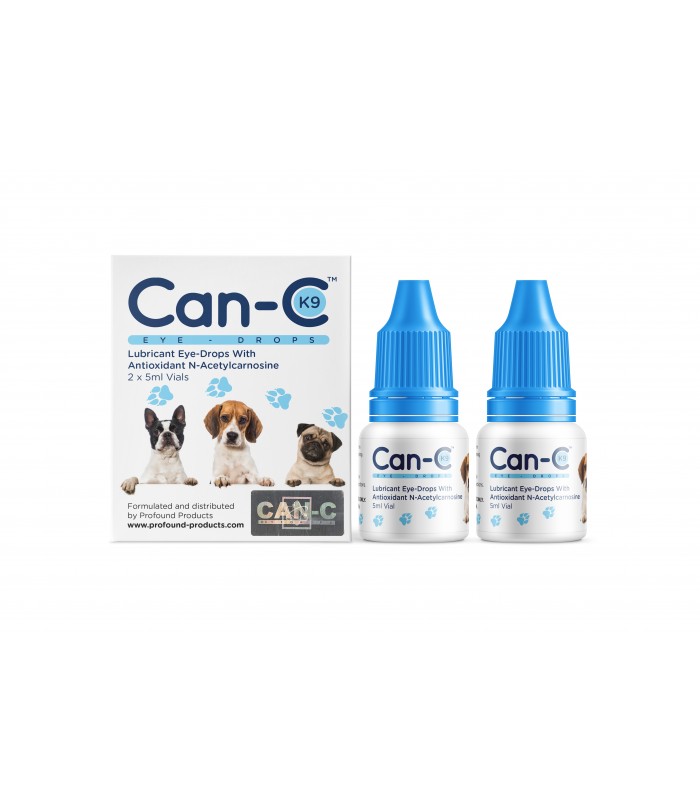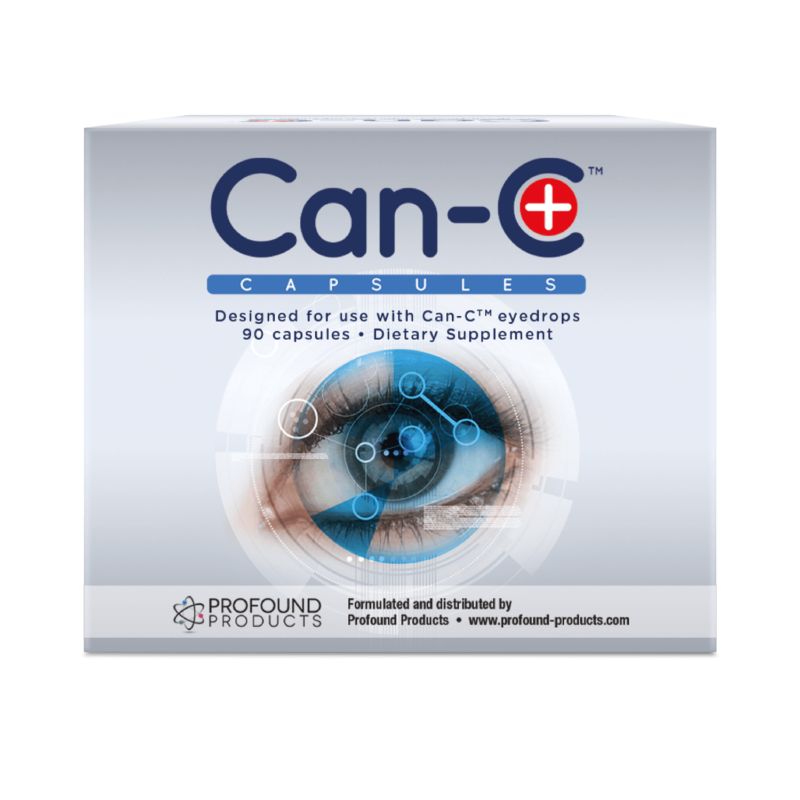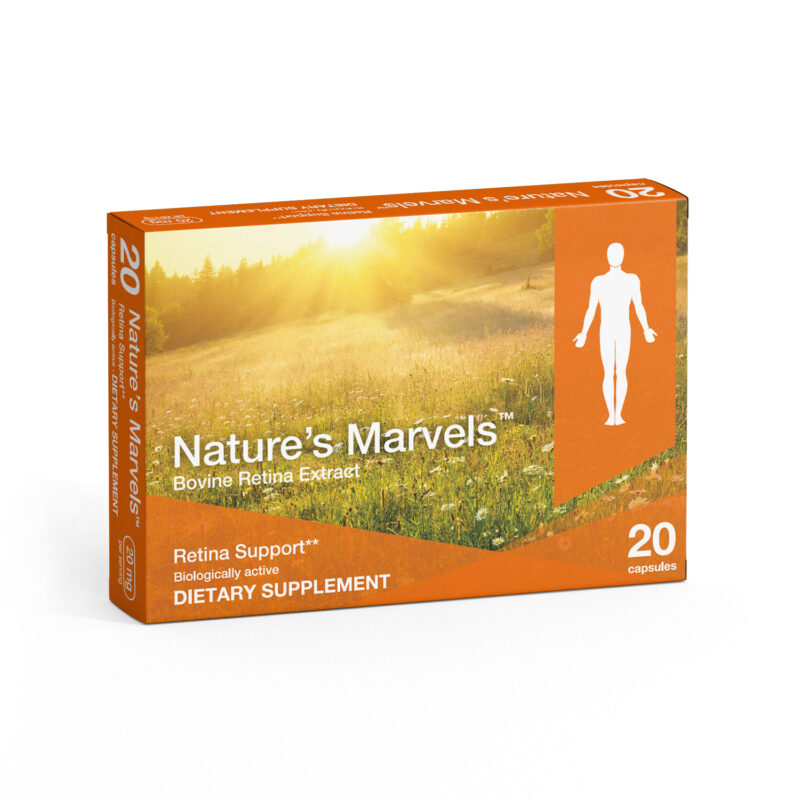
Can-C™K9 (N-Acetylcarnosine eye drops for dogs)
Lubricant Eye Drops with N-Acetylcarnosine for dogs
Lubricant Eye Drops with N-Acetylcarnosine for dogs. These eye drops are based on the original Can-C™ formula.
This product has the
following ingredients
This product is associated with the following health conditions
Animal Use ARMD (age related macular degeneration) Cataract Dry Eyes Eyesight Glaucoma Macular degeneration Pets RetinaProduct Description
Can-C™ Eye Drops: Normalise Cataract impairment, without surgery
Can-C™ eye drops are the original N-acetylcarnosine (often shorted to NAC) eye drop formula developed to normalise senile cataract impairment.
In addition to senile cataract impairment, Can-C™ may also have other benefits. Although the information is not yet published, Russian researchers believe “that the unique Can-C™ formula with its added and synergistic lubricants, could also have benefit in the following eye disorders.
Users and scientists have reported that Can-C™ is also great for:
- Dry eye syndrome.
- Benefit for those who wear contact lenses, particularly soft contact lenses. (Not only do the lubricants in Can-C™ help contact lenses more comfortable, but N-acetylcarnosine is also believed to inhibit the build up of lactic acid in the eye, meaning you can wear them in comfort for longer.)
- Corneal disorders.
- Computer vision syndrome.
- Eye strain.
- Ocular inflammation.
- Blurred vision.
- Presbyopia.
- Retinal diseases.
- Vitreous opacities and lesions.
- Complications of diabetes mellitus and other systemic diseases.
- Open-angle primary glaucoma.”
Cataract surgery is the most commonly performed operation in the world with over 1.5 operations in the USA alone every year. Although generally safe there is still a complication rate of 30 to 50% of patients who develop opacification of the posterior lens capsule within two years and require further lazer treatment. Can-C™ cataract eye drops have helped thousands of people normalise their cataracts without surgery, leaving the natural lens in place rather than an artificial one.
Research shows how Can-C™ Drops work to normalise cataract impairment
Can-C™ contains a special analogue of the di-peptide carnosine, a naturally occurring nutrient that combines two amino acids or protein fragments. This particular form is known as N-acetylcarnosine or NAC and is the main ingredient due to its potency at ‘mopping up’ free radicals, the root cause of tissue damage, accelerated aging in the body and cataracts.
Cataracts are caused by the process of cross linking or glycosylation, as we age our natural anti-oxidant defense against glycosylation declines, leading to the eye lens to harden and discolour over the course of a lifetime.
Other forms of carnosine are broken down by naturally occurring enzymes in the eye, but the researchers found that the N-acetylcarnosine form is highly resilient and conveys the L-carnosine directly to the aqueous humor. Once in the fluid it provides the lens proteins with complete anti-oxidant protection against oxidation caused by free radicals.
Human trials on people suffering from senile cataract, using a twice daily dose of Can-C™ for six months showed the following remarkable results:
- 88.9 per cent of patients had improved glare sensitivity
- 90 per cent reported improved visual acuity – clearer and sharper vision
- Perhaps most significantly, 41 per cent of patients experienced a significant improvement in lens ‘transmissivity’.
And whilst the patients were taking the NAC carnosine eye drops, the lead researcher noted that there was no recurrence of cataract.
Typical use of Can-C™ Eye drops
Can-C™ eye drops have been shown to have measurable effects within only 1-month of use, but for maximum efficacy, it is recommended that administration continue for 3-5 months. N-actylcarnosine works best the sooner it is used after a cataract is detected.
Typical courses of treatment are:
Two drops twice a day in one eye meaning 2 bottles (1 box) will last a month
2 drops twice a day in two eyes meaning 2 bottles (1 box) will last about 2 and a half weeks.
Senile cataracts are an on-going aging disorder so N-acetylcarnosine may be required on a regular basis to help maintain the eye’s natural anti-oxidant defences, so a maintenance dose of 1 drop twice a day in both eyes is highly recommended and one box would last a month.
Can-C™ reportedly the tried and tested alternative to Cataract Surgery
Can-C™ is the only patented NAC eye drops for cataract, the only carnosine eye drops that use the exact formula that was used in both the animal and human trials. They are the first and only proven N-actylcarnosine eye drops that offer a cost effective, non-invasive alternative to cataract surgery.
Frequently Asked Questions About Can-C™ Eye Drops
Disclaimer: Please note that only your own physician can determine your precise needs, but in order to give you some information these answers are based upon the ‘average person’ and clinical / published results.
Hello, I’m dealing with recurrent cornea eye erosions. I’m wearing a Acuvue Oasys with Hydraclear Plus bandage contact. Can I use Can-C™ with the bandage contact? I have tested it in my good eye (with no contact in it) with no problem.Also, couldl it gum up the bandage contact? I’m having trouble the contact sticking to my eye. Thank you for your time and help:)
KK, USA
The lubricant properties of Can-C™ eye drops can stimulate the hydrating effect of Hydraclear Plus for contact lenses and bandage contact lens specifically for this clinical case, also the properties of N-acetylcarnosine and released carnosine from this prodrug at the corneal surface can stimulate the healing of the corneal erosion.
So, in total, there might be only positive effect of Can-C™ eye drops during the combined use with above captured bandage contact lens embodiment.
Can Can-C™ be taken in conjunction with other common eye supplements such as lutein and zeaxanthin / astaxanthin?
We do not recommend that the Can-C™ eye-drops are combined with lutein (unless a patient has a cataract associated with a retinal disorder), this is because lutein appears to block the receptor sites and may lower the efficacy of the results. You should stop taking lutein for at least the first 6 months but after this period they may be started again. This is because Can-C™ does the majority of its restorative work in that period and thereafter it is maintenance, thus a reduced efficacy is not so essential.
The same is true for zeaxanthin; however we are not aware of contraindications with astaxanthin.
Can one eat spirulina and other superfoods when using Can-C™? Are they considered foods or supplements, with problems similar to other caretenoids when using Can-C™?
The only known contraindication is with lutein competing with the same receptors in the eye as the n-acetylcarnosine. This does not mean that the combined intake of lutein with use of Can-C™ Eyedrops would invalidate the effectiveness, but it’s efficacy could be reduced which may mean a longer treatment time.
Are there any problems using Can-C™ concurrently with Xalatan® eye-drops for glaucoma pressure control? Would you recommend use of both?
To date there have been no noted contraindications or side effects noted with the use of other eye-drops combined with Can-C™, but naturally as there are so many versions, not all eye-drops have been tested along with the same. The inventors stated that beta blocker eye-drops used for glaucoma may actually have additional benefit when combined with Can-C to help further reduce the intraocular pressure.
How long has Can-C™ has been on the market?
Can-C™ has been sold since 2001 and in that time has helped thousands of people cure their senile cataracts without painful surgery. In fact it is estimated that there have been 50,000 documented patient cases of Can-C™ use.
Can I continue to use vitamin A and E supplements whilst using Can-C™?
It is the inventors assertion that certain substances, including vitamins A and E inhibit the conversion process of the NAC into L-carnosine INSIDE the aqueous humor of the eye. He does not endorse them – rather the opposite at least when used topically (however if vitamin A or E are taken orally there is no contraindication).
It is interesting to note that the copycat products have now stopped adding A and E to their formula, they simply do not understand how this technology performs.
Why does the Can-C™ packaging say it is an eye lubricant rather than a treatment for cataract?
Can-C™ is packaged for relief of dry eyes; it is not an approved drug to ‘treat cataracts’ in the eyes of the FDA. The suggestion refers to the uses and clinical trials that the Russians have performed.
Can-C™ is not approved as a drug by the FDA because no submission has been made to do so, the requirements for drug approval are so costly that a molecule patent is required beforehand, as Can-C™ is a natural product, it is extremely difficult to obtain a patent for a natural molecule and hence the process doesn’t get started.
How does Can-C™ differ from other N-acetylcarnosine eye drops on the market?
Can-C™ is the original eye-drop that mimics the research, it is also the only version tested and approved by the institute, who conducted those clinical trials.
Are Can-C™ eye drops ok for vegans?
There are no animal ingredients in Can-C™ eye drops, all are 100% plant based; therefore the product is suitable for both vegetarians and vegans.
Do Can-C™ eye drops work for other eye conditions?
Open-angle primary glaucoma
Can-C™ eye-drops have been recommended by the inventors who have suggested that it is a useful adjunct in the condition of open angle glaucoma. Although not proven, it is believed that the anti-glycosylation properties of Can-C™ reduce the accumulation of proteins from around the schlemm canal (the valve in the eye), thus over time precipitating a release of pressure in the eye by allowing more waste materials to pass through into the bloodstream.
Floaters
We don’t have any clinical evidence for floaters. Can-C™ eye-drops have been successful in a number of other applications – other than cataract, but unfortunately floater’s is not one of them.
Subcapsular cataracts
At present the clinical trials have focused on cataracts of the senile type – perhaps because they are the most common. At present there is anecdotal evidence to support role in other cataracts and aging eye disorders, perhaps because the delivery of carnosine is a natural defence mechanism inside the eye. The inventor of the technology does predispose that Can-C™ will be effective for other cataracts; details have been noted inside the book ‘The Cataract Cure’ by Marios Kyriazis, M.D.
My optician says that my cataract is worse than last time but I can see better, how is this possible?
We are finding that in some cases that the cataract after treatment approximately the same size or in some cases is perceived as larger. This may be because the action of the drops is upon the crystallins within the lens, effectively making them clearer, whilst not perhaps reducing the amount / size of the cataract.
Normally most patients will see an improvement of glare sensitivity (usually stated as improvements to night driving), then enhanced color perception and of course the ability to read additional lines on an eye chart, a clear sign of improving eye sight.
Effectively it can take several more months (in some cases) to actually reduce the size of the cataract, please note that the addition of Can-C™ Plus, the new oral formula, can be taken alongside the eye-drops to help speed up this process.
Can a person who is diabetic use the Can-C™?
Yes, in fact the inventor recommends them for diabetic retinopathy.
Is it safe and appropriate that a person use Can-C™ after they have already had cataract surgery?
Yes! Although it will not affect the replacement lens as that is made of plastic, however Can-C™ can support the eye in other ways to ensure that other deterioration is avoided or at least delayed.
Many patients are using Can-C™ in this way, as there is no deterioration to the plastic of the artificial lens and Can-C™’s actions can help to maintain other eye structures – in our opinion its use is still worthy in such cases.
Will Can-C™ eye drops work even though I wear contact lenses?
Yes in fact they can benefit contact lens wearing in 2 ways, firstly they inhibit the accumulation of lactic acid, thereby reducing the pain associated with contacts and secondly the lubricants in Can-C™ make wearing the contacts more comfortable.
One thing we would recommend is that contacts be removed as normal, the eye washed with cold water and gently dabbed dry and then apply the Can-C™ and wait 15 minutes (this gives the eye-drop time to pass through the membranes and enter the eye) before replacing the contact lens as normal. Note that although this is not an essential requirement, it may be beneficial to do so.
Can Can-C™ be used to treat cataracts in dogs and other pets?
Yes, Can-C™ has been effectively tested on dogs and rabbits. In fact because these animals lack an enzyme called carnosinase (which is found in humans) the drops actually work much faster. This is because the lack of carnosinase means that more of the active ingredient enters the eye and therefore more of the active ingredient is delivered. The only drawback is that administering the drops to animals may mean more loss as the animal blinks or shakes its head etc. But the bottom line is that Can-C™ is known to improve the dog’s vision when applied daily for several weeks.
Has Can-C™’s pH level changed and what effect will that have?
The pH of Can-C™ has been changed from early setting of 6.7 to 6.9 whilst technically there is a minute reduction in the uptake of the n-acetylcarnosine this has not in any way reduced the efficacy of Can-C™ eye-drops. It just means that Can-C™ is a much more comfortable product to use compared to other NAC containing products on the market, reducing the potential of stinging effects from 1 in 7 persons to 1 in 700 persons, so Can-C™ is less likely to generate this uncomfortable side effect than other copycat products.
How do I store Can-C™ eye drops?
Can-C™ is stable for lengthy periods at room temperature, although at home we recommend that you keep them in the warmest part of the fridge (i.e. the door). This is especially true with opened bottle’s which should be discarded 28 days after opening (but if you are using the drops every day as recommended the bottle will be empty after 14 days).
Can Can-C™ be damaged if it is frozen in transit?
There is no impact of frozen temperature on samples
How is Can-C™ delivered into the eye?
The lens itself is inside the eye, floating in a liquid called the aqueous humour, the outer part of the eye (the part you can touch) normally inhibits absorption, but Can-C™ has been specially designed to pass through the outer membranes and deliver carnosine into the fluid of the eye, thus making contact with the lens and helping to prevent glycosylation, the process that clouds the crystallins in the lens etc.
Do Can-C™ eye drops have any influence on eye pressure?
All the current clinical trial support that in the majority of cases that Can-C™ lowers the intraocular pressure, we have not heard reports of increased pressure to date. Officially the trials have been conducted in cataracts, specifically senile cataracts, however as has been made clear in Dr. Marios Kyriazis book ‘The Cataract Cure, the story of n-acetylcarnosine’ there have been a number of other noted improvements including some reduction in the intraocular pressure of the eye and we have received a number of statements to that affect also.
What standard is Can-C™ manufactured to?
Can-C™ is made to pharmaceutical standards under cGMP and ISO9001 standards in an approved and licensed facility. Can-C™ is the only NAC eye-drop that is approved, tested and recommended by the inventors.
Where can I read clinical studies about Can-C™ and N-acetylcarnosine?
I am basically healthy and elderly. I have mild cataracts AND early-stage dry AMD. Have read your materials extensively, I realize that with Can-C™, most emphasis is on support for cataracts but that it does support “other eye conditions.” QUESTION 1: Are you aware of any potential negative effects to AMD condition if taking Can-C™ for cataracts? QUESTION 2: Should I add Aminoguanidine? QUESTION 3: Should I add Metformin, even though I’m not diabetic? Many thanks for excellent website and for your reply.
Yes Can-C™ can assist aging eyes for many other types of disorders, but it is not clear if it can be truly successful in AMD. You need to know about the melatonin trial with AMD, you can click here for this information.
Note; we now have a special add-on oral product called Can-C™ Plus, which is designed to be used alongside the Can-C eye-drops in difficult cases.
My son, age 32, is suffering from retinitis pigmentosa. As a result, in recent years he has developed a subcapsular posterior cataract. I would like him to avoid cataracts surgery, due to the possible complications on RP. Are your eye drops useful for this purpose? Another question: I live in Rome. Have you in Italy some organization?
It’s possible that it could help, it has been useful with many different forms of cataract; much depends on how long your son has had this cataract, with the shorter time the better. To be sure of effectiveness it is best to use the drops (2 into the affected eye twice a day) for a period of 3-5 months, hopefully some improvement may be noted much quicker, look for signs such as improved reading of eye-chart, better color perception or improved night glare (for example looking at car lights). I don’t believe there is an outlet currently in Italy but your order would arrive promptly from the UK.
I am very encouraged by what I have read about Can-C™ eye drops, both journal articles and patient testimonials, and I have a question: I developed a cataract in one eye as a result of a vitrectomy procedure required for a detached retina one year ago. Is Can-C™ appropriate for this type of cataract condition or just senile cataracts?
There’s no reason to presume that Can-C™ won’t be effective for any form of cataract, whilst the clinical data surrounds senile cataracts, over the years we have received much anecdotal evidence for many other kinds of cataracts and indeed eye disorders. It is no accident that the eye naturally uses carnosine in its defence mechanism and ergo replacing it as it declines with age helps to support its natural defences, there is a lot of technical data to be see at www.nacetylcarnosine.com
I need to know if there is a limit to how long one uses Can-C™. I have been using it to control or eliminate cataracts and it seems to help with my dry eyes. Please advise me if it is okay to use indefinitely, or if I should limit its use. I use one drop in each eye, twice a day. I have been following this regimen for about 2 years.
As you probably know the clinical trials were conducted for 2 years and there were no signs of any issues in that time. We have clients who have been using it (and monitoring it) for more than 3 years, again in these cases there have been no complaints and a continuing benefit.
It is our belief that because Can-C™ contains natural ingredients, many of which the eye uses in its own defence, that they can be used for very long periods as an antiaging guard. As you are using the maintenance dose this seems practical, it could be possible for you to reduce it to just 1-drop once a day, particularly if you combined it with the new Can-C™ Plus capsules (3 per day).
I have gone through cataract surgery many years ago and I am wondering how can the Can-C™ solution pass through the plastic lens implanted in my eyes and deliver the beneficial effects of the eye drop to the eyes.
The lens floats in the liquid of the eye called the aqueous humor, therefore it doesn’t act as a block to tissues behind it. We have a number of people with artificial lenses using Can-C and there have been no complications noted to date.
Can-C™ Eye Drops dosage
As a preventative measure, two drops into both eyes once a day may be a suitable on-going regime. As for treatment, two drops into the affected twice daily is the ideal regime – there is no benefit in exceeding this dose. It is recommended that occasional use of N-acetylcarnosine eye-drops continue even after the reduction / reversal of the cataract to prevent any re-occurrence.
Can-C™ side effects
To date, no serious side effects or contraindications have been noted in any of the clinical trials.
- Further Information
- Can-C™ Plus
Can-C™K9 (N-Acetylcarnosine eye drops for dogs) Testimonial
THANK YOU FOR MAKING CAN-C AVAILABLE!!! I am legally blind in one eye. When my ophthalmologist said I needed cataract surgery on my good eye, I was frightened. While it is a common procedure, having only one good eye, I didn’t want to risk it. For several years I tried a very expensive product that did nothing for it. Then I found Can-C. I have used it for 3-4 years, and have close to 20/20 vision in that good eye.
I’m 84 years old, and can still see well. It has kept the cataracts from progressing, and spared me the surgery. I dumped that ophthalmologist because for 3 or 4 years, all he said was that I really needed cataract surgery, and overlooked the fact that I needed new glasses. When using it, I do keep the drops in twice as long, and move my eyes around while closed. This is a fantastic product! I’m so glad I found it! THANK YOU SOOOOO MUCH. Geraldine






